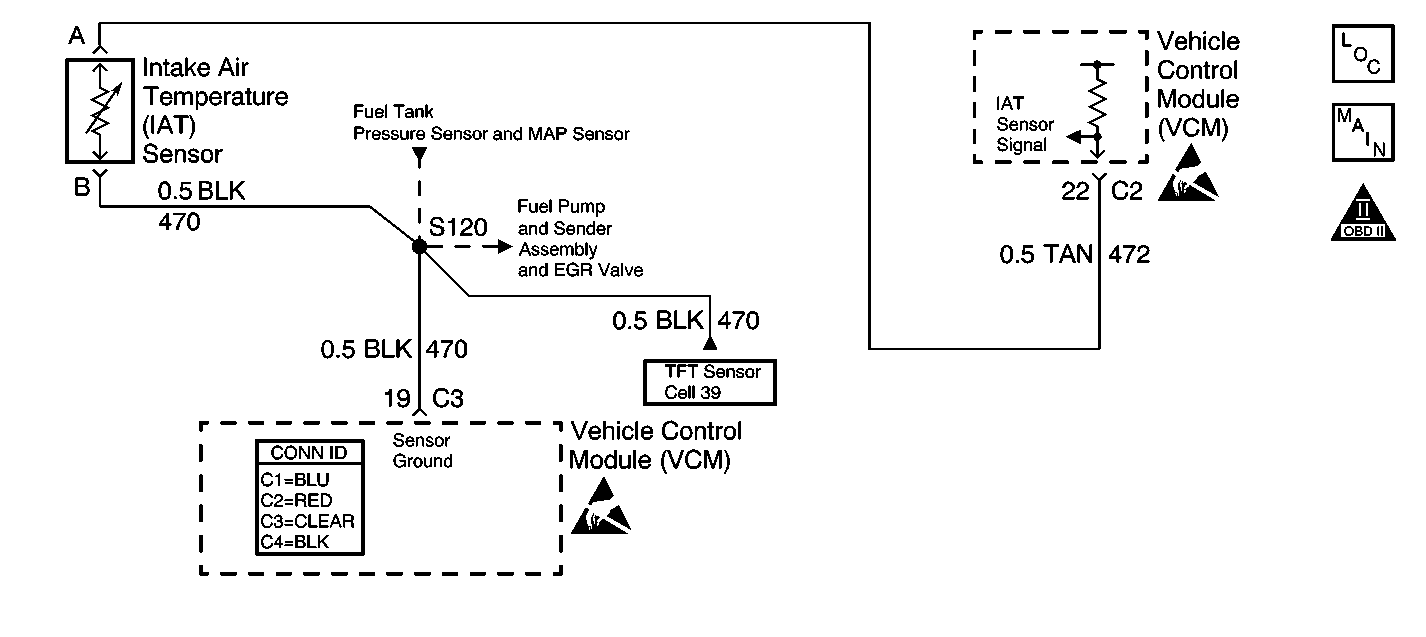
Circuit Description
The intake air temperature (IAT) sensor is a thermistor. The control module supplies the IAT sensor a reference voltage on the IAT sensor signal circuit and a ground circuit. When the IAT sensor resistance is high, indicating a cold sensor, the IAT sensor signal voltage remains near the supplied voltage and decreases the signal voltage as the sensor warms. The control module monitors the IAT sensor signal circuit in order to calculate the temperature of the air entering the engine.
This DTC is designed to detect intermittent high voltage signals on the IAT sensor signal circuit.
Conditions for Running the DTC
| • | No active engine coolant temperature (ECT) sensor DTCs |
| • | No active vehicle speed sensor (VSS) DTCs |
| • | No active mass air flow (MAF) sensor DTCs |
| • | The vehicle speed is more than 3 km/h (2 mph). |
| • | The mass air flow (MAF) is less than 250 g/s. |
| • | The engine coolant temperature (ECT) is more than 85°C (184°F). |
| • | The engine has been running for more than 100 seconds. |
Conditions for Setting the DTC
The vehicle control module (VCM) detects an intermittent high IAT voltage while the engine is running.
Action Taken When the DTC Sets
| • | The control module stores the DTC in history after the first failure but will not illuminate the malfunction indicator lamp (MIL). |
| • | The control module records the operating conditions at the time the diagnostic fails. The control module stores the failure information in the scan tools Freeze Frame/Failure Records. |
Conditions for Clearing the MIL/DTC
| • | A history DTC will clear if no fault conditions have been detected for 40 warm-up cycles. |
| • | A warm-up cycle occurs when the coolant temperature has risen 22°C (40°F) from the startup coolant temperature and the engine coolant temperature exceeds 70°C (160°F) during the same ignition cycle. |
| • | Use the scan tool Clear Information function. |
Diagnostic Aids
The IAT sensor measures the temperature of the ambient air entering the throttle body. The scan tool displays the IAT as volts and temperature. The IAT temperature should be nearly the same as the temperature of the outside air. The intake air temperature should rise gradually as the engine warms up and the underhood temperature increases. This DTC could set if the IAT sensor ground circuit is intermittently open or the IAT sensor signal circuit is intermittently open or shorted to voltage. If a high IAT voltage reading is present, additional sensor circuit voltage codes could be set. Refer to any non-intermittent DTCs that are set. Also, a sensor may become skewed or mis-scaled. The Temperature vs. Resistance table will help to detect a skewed sensor.
Inspect for intermittents.
An intermittent may be caused by any of the following conditions:
| • | A poor connection |
| • | Rubbed through wire insulation |
| • | A broken wire inside the insulation |
Thoroughly inspect any circuitry that is suspected of causing the intermittent complaint. Refer to Testing for Intermittent Conditions and Poor Connections in Wiring Systems.
If a repair is necessary, refer to Wiring Repairs or Connector Repairs in Wiring Systems.
Test Description
The number below refers to the step number on the diagnostic table.
Step | Action | Values | Yes | No |
|---|---|---|---|---|
1 | Did you perform the Powertrain On-Board Diagnostic (OBD) System Check? | -- | Go to Step 2 | |
|
Important: Be sure to use the same diagnostic test equipment for all measurements.
Is the voltage more than the specified value? | 4.9 V | Go to DTC P0113 Intake Air Temperature (IAT) Sensor Circuit High Voltage | Go to Step 3 | |
3 |
Did you find a problem? | -- | Go to Step 6 | Go to Step 4 |
4 |
Did you find a problem? | -- | Go to Step 6 | Go to Step 5 |
5 |
Does the voltage fluctuate? | -- | Go to Step 6 | Go to Diagnostic Aids |
6 | Repair the circuit as necessary. Refer to Wiring Repairs or to Connector Repairs in Wiring Systems. Is the action complete? | -- | Go to Step 7 | -- |
7 |
Does the scan tool indicate the diagnostic Passed? | -- | Go to Step 8 | Go to Step 2 |
8 | Does the scan tool display any additional undiagnosed DTCs? | -- | Go to the applicable DTC table | System OK |
